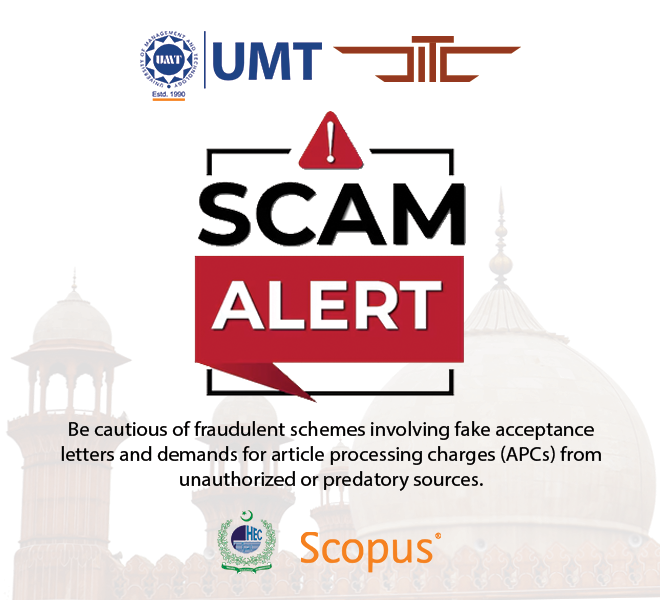Shari‘ah Issues in Islamic Capital Markets of Pakistan
A Case Study of Sukūk
Abstract
 Abstract Views: 550
Abstract Views: 550
Islamic Capital Markets (ICM) are playing an important role in raising long term funds and thus playing their role in economic growth and development of a country. Sukūk are important Islamic Capital Market instruments through which long term funds are obtained from general public. Sukūk are certificates of equal
value representing undivided shares in ownership of tangible assets, usufructs and services, or in the ownership of the assets of particular projects or special investment activities. Sukūk market in Pakistan is regulated by the Securities and Exchange Commission of Pakistan (SECP). Despite the continuous growth
of Sukūk market in Pakistan, there are various Shari‘ah issues which are still prevalent in the Sukūk structures which need our attention in order to make the Sukūk Shari‘ah compliant in true spirit of Islam. The main objective of this paper to discuss and elaborate the various Shari‘ah issues prevailing in Islamic
Capital Markets of Pakistan, especially related to Sukūk. It is argued that while structuring Sukūk, the various features of conventional bonds are replicated while compromising the various Shari‘ah injunctions. The current practices of various financial institutions are discussed and various Shari‘ah issues related to different types of Sukūk are identified and the point of view of various scholars on these issues is also discussed. The various Shari‘ah issues related to Sukūk which are identified in this article include purchase undertaking in equity based structures, late payment penalty upon default, ownership status in asset based
transactions and trading of debt based Sukūk. So this paper highlights the need for a balance between growth in the Sukūk market and meeting the Shari‘ah requirements while structuring Sukūk.
Downloads
References
Standard No.12.” Manama, 2017. http://aaoifi.com/Shari‘ah a-standards/?lang=en.
———. “AAOIFI Shari‘ah Standard No.17.” Manama, 2017. http://aaoifi.com/Shari‘ah astandards/?lang=en.
Al-Amine, Muhammad Al-Bashir. “Sukūk Market: Innovations and Challenges.” 2008.
Ayub, Huma., and Behzad S. Kawish. “Design and Use of Innovative Islamic Capital Market
Products: Experience of Pakistan and Malaysia.” Islamic Capital Markets 2008.
Azhar Rosly, Saiful. “Shari‘ah Parameters Reconsidered.” International Journal of Islamic and
Middle Eastern Finance and Management 3, no. 2 (2010): 132–146.
“Capital Markets – Data and Statistics | SECP.” Accessed May 8, 2019.
https://www.secp.gov.pk/data-and-statistics/capital-markets/.
Dusuki, Asyraf Wajdi. “Do Equity-Based Sukūk Structures in Islamic Capital Markets Manifest
the Objectives of Shari'ah??” Journal of Financial Services Marketing 15, no. 3 (2010):
203–214.
Dusuki, Asyraf Wajdi, and Shabnam Mokhtar. Critical Appraisal of Shari'ah Issues on
Ownership in Asset-Based Sukūk as Implemented in the Islamic Debt Market. Kuala
Lumpur : International Shari'ah Research Academy for Islamic Finance (ISRA), 2010.
International Islamic Financial Market. “IIFM Sukūk Report 2018.” IIFM Sukūk Report 2018.
Manama: International Islamic Financial Market, 2018.
http://www.iifm.net/system/files/private/en/IIFM%20Sukuk%20Report%20%287th%20E
dition%29_0.pdf.
K-Electric Limited. “ K-Electric Sukūk Prospectus.” n. d.
https://www.ke.com.pk/download/financial-data/AZM-Sukuk-Prospectus.pdf.
Majmaʻ al-Fiqh al-Islāmī (Organisation of Islamic Conference), and Islamic Research and
Training Institute. Resolutions and Recommendations of the Council of the Islamic Fiqh
Academy: Muqaradha Bonds and Investment Certificates. Jeddah, Saudi Arabia: Islamic
Development Bank, 2000. http://zulkiflihasan.files.wordpress.com/2009/12/majmafiqh.pdf.
“Maple Leaf Cement | Business Recorder.” Accessed May 6, 2019.
https://fp.brecorder.com/2012/07/201207031208545/.
Maurer, Bill. “Form versus Substance: AAOIFI Projects and Islamic Fundamentals in the Case of
Sukuk.” Journal of Islamic Accounting and Business Research 1, no. 1 (2010): 32–41.
Muhammad, Marjan, and B. S. Sairally. “Shari‘ah Criticisms against Sukuk, w: Sukūk
Perceptions and Forecast Study 2014, Red.” EA Alim, Thomson Reuters Zawya, 2013,
112–116.
“Pakistan Stock Exchange Limited -.” Accessed May 5, 2019. https://www.psx.com.pk/.
Radzi, Rafisah Mat, and Mervyn K. Lewis. “Religion and the Clash of ‘Ideals’ and ‘Realities’ in
Business: The Case of Islamic Bonds (Sukuk).” Thunderbird International Business
Review 57, no. 4 (2015): 295–310.
Rosly, Saiful Azhar, and Mahmood Sanusi. “Some Issues of Bay’al-’inah in Malaysian Islamic
Financial Markets.” Arab Law Quarterly 16, no. 3 (2001): 263–280.
Securities Commission Malaysia. “Resolutions of the Shari'ah Advisory Council of the Securities
Commission Malaysia: Kafalah in Sukūk Structuring.” Kuala Lumpur, 2018.
https://www.sc.com.my/api/documentms/download.ashx?id=5f0c31dc-daa9-43c1-80ace7ecf70c8e44.
“Sukūk Issued by Maple Leaf Cement Factory Fully Redeemed: Rating Withdrawn | Pakistan
Press International.” Accessed May 6, 2019. https://ppinewsagency.com/Sukuk-issuedby-maple-leaf-cement-factory-fully-redeemed-rating-withdrawn/.
The Third Pakistan International Sukūk Company Limited. “Prospectus of the Third Pakistan
International Sukūk Company Limited.” Pakistan, 2016. https://www.Sukuk.com/Sukuknew-profile/the-third-pakistan-international-Sukuk-co-ltd-5031/.

This work is licensed under a Creative Commons Attribution 4.0 International License. Authors retain copyright and grant the journal right of first publication with the work simultaneously licensed under a Creative Commons Attribution (CC-BY) 4.0 License that allows others to share the work with an acknowledgement of the work’s authorship and initial publication in this journal.








